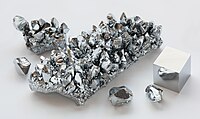
Photo from wikipedia
The LF refining process of Ti-stabilized stainless steel melts involves deoxidation by Al followed by Ti alloy addition for binding the interstitial elements C and N.1,2) However, the deoxidation products… Click to show full abstract
The LF refining process of Ti-stabilized stainless steel melts involves deoxidation by Al followed by Ti alloy addition for binding the interstitial elements C and N.1,2) However, the deoxidation products can potentially cause the clogging of submerged entry nozzle (SEN) and the surface defects of steel products.3–5) Thus, it is necessary to control the formation of oxide inclusions in Ti-bearing stainless steel. Aluminum is usually added before titanium addition to reduce the formation of Ti-containing inclusions and improve Ti yield.5,6) Al2O3 and spinel (MgO–Al2O3) inclusions were generally formed after Al deoxidation. Spinel inclusions were formed due to soluble Mg supplied from the slag and MgO-based refractory.7–9) These inclusions could lead to the nozzle clogging.10–13) In order to prevent the clogging of SEN, some studies have been carried out to modify these inclusions to liquid oxide by calcium treatment. Harkness et al.14) reported that calcium treatment made little difference to the composition or morphology of spinel inclusions. Kor15) also have pointed out that the modification of MgO·Al2O3 spinel with calcium was expected to be less effective than the modification of pure alumina. However, more researchers have found that calcium treatment could Formation and Evolution of Oxide Inclusions in Titanium-Stabilized 18Cr Stainless Steel
Journal Title: ISIJ International
Year Published: 2018
Link to full text (if available)
Share on Social Media: Sign Up to like & get
recommendations!